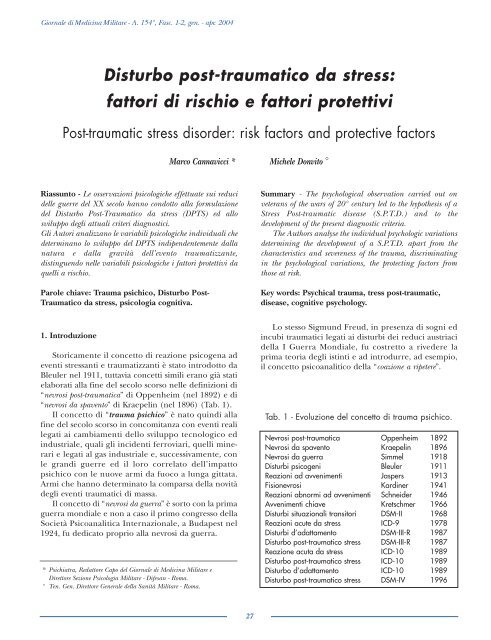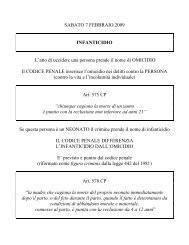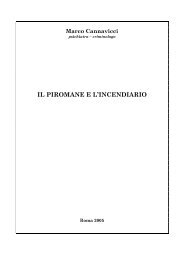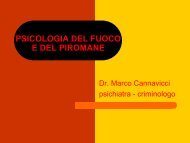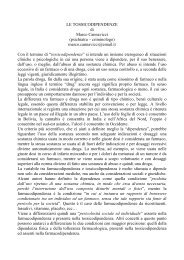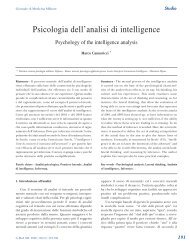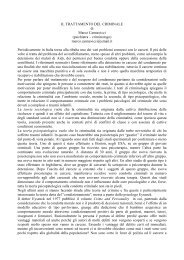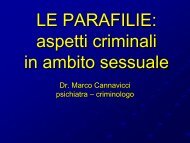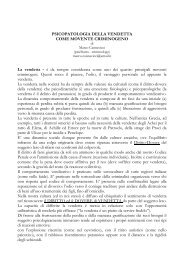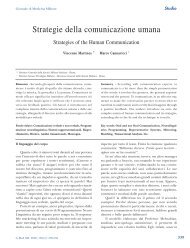Disturbo post-traumatico da stress: fattori di ... - Marco Cannavicci
Disturbo post-traumatico da stress: fattori di ... - Marco Cannavicci
Disturbo post-traumatico da stress: fattori di ... - Marco Cannavicci
You also want an ePaper? Increase the reach of your titles
YUMPU automatically turns print PDFs into web optimized ePapers that Google loves.
Giornale <strong>di</strong> Me<strong>di</strong>cina Militare - A. 154°, Fasc. 1-2, gen. - apr. 2004<br />
1. Introduzione<br />
<strong>Disturbo</strong> <strong>post</strong>-<strong>traumatico</strong> <strong>da</strong> <strong>stress</strong>:<br />
<strong>fattori</strong> <strong>di</strong> rischio e <strong>fattori</strong> protettivi<br />
Post-traumatic <strong>stress</strong> <strong>di</strong>sorder: risk factors and protective factors<br />
Riassunto - Le osservazioni psicologiche effettuate sui reduci<br />
delle guerre del XX secolo hanno condotto alla formulazione<br />
del <strong>Disturbo</strong> Post-Traumatico <strong>da</strong> <strong>stress</strong> (DPTS) ed allo<br />
sviluppo degli attuali criteri <strong>di</strong>agnostici.<br />
Gli Autori analizzano le variabili psicologiche in<strong>di</strong>viduali che<br />
determinano lo sviluppo del DPTS in<strong>di</strong>pendentemente <strong>da</strong>lla<br />
natura e <strong>da</strong>lla gravità dell’evento traumatizzante,<br />
<strong>di</strong>stinguendo nelle variabili psicologiche i <strong>fattori</strong> protettivi <strong>da</strong><br />
quelli a rischio.<br />
Parole chiave: Trauma psichico, <strong>Disturbo</strong> Post-<br />
Traumatico <strong>da</strong> <strong>stress</strong>, psicologia cognitiva.<br />
Storicamente il concetto <strong>di</strong> reazione psicogena ad<br />
eventi <strong>stress</strong>anti e traumatizzanti è stato introdotto <strong>da</strong><br />
Bleuler nel 1911, tuttavia concetti simili erano già stati<br />
elaborati alla fine del secolo scorso nelle definizioni <strong>di</strong><br />
“nevrosi <strong>post</strong>-traumatica” <strong>di</strong> Oppenheim (nel 1892) e <strong>di</strong><br />
“nevrosi <strong>da</strong> spavento” <strong>di</strong> Kraepelin (nel 1896) (Tab. 1).<br />
Il concetto <strong>di</strong> “trauma psichico” è nato quin<strong>di</strong> alla<br />
fine del secolo scorso in concomitanza con eventi reali<br />
legati ai cambiamenti dello sviluppo tecnologico ed<br />
industriale, quali gli incidenti ferroviari, quelli minerari<br />
e legati al gas industriale e, successivamente, con<br />
le gran<strong>di</strong> guerre ed il loro correlato dell’impatto<br />
psichico con le nuove armi <strong>da</strong> fuoco a lunga gittata.<br />
Armi che hanno determinato la comparsa della novità<br />
degli eventi traumatici <strong>di</strong> massa.<br />
Il concetto <strong>di</strong> “nevrosi <strong>da</strong> guerra” è sorto con la prima<br />
guerra mon<strong>di</strong>ale e non a caso il primo congresso della<br />
Società Psicoanalitica Internazionale, a Bu<strong>da</strong>pest nel<br />
1924, fu de<strong>di</strong>cato proprio alla nevrosi <strong>da</strong> guerra.<br />
* Psichiatra, Re<strong>da</strong>ttore Capo del Giornale <strong>di</strong> Me<strong>di</strong>cina Militare e<br />
Direttore Sezione Psicologia Militare - Difesan - Roma.<br />
° Ten. Gen. Direttore Generale della Sanità Militare - Roma.<br />
<strong>Marco</strong> <strong>Cannavicci</strong> * Michele Donvito °<br />
27<br />
Summary - The psychological observation carried out on<br />
veterans of the wars of 20° century led to the hypothesis of a<br />
Stress Post-traumatic <strong>di</strong>sease (S.P.T.D.) and to the<br />
development of the present <strong>di</strong>agnostic criteria.<br />
The Authors analyse the in<strong>di</strong>vidual psychologic variations<br />
determining the development of a S.P.T.D. apart from the<br />
characteristics and severeness of the trauma, <strong>di</strong>scriminating<br />
in the psychological variations, the protecting factors from<br />
those at risk.<br />
Key words: Psychical trauma, tress <strong>post</strong>-traumatic,<br />
<strong>di</strong>sease, cognitive psychology.<br />
Lo stesso Sigmund Freud, in presenza <strong>di</strong> sogni ed<br />
incubi traumatici legati ai <strong>di</strong>sturbi dei reduci austriaci<br />
della I Guerra Mon<strong>di</strong>ale, fu costretto a rivedere la<br />
prima teoria degli istinti e ad introdurre, ad esempio,<br />
il concetto psicoanalitico della “coazione a ripetere”.<br />
Tab. 1 - Evoluzione del concetto <strong>di</strong> trauma psichico.<br />
Nevrosi <strong>post</strong>-traumatica Oppenheim 1892<br />
Nevrosi <strong>da</strong> spavento Kraepelin 1896<br />
Nevrosi <strong>da</strong> guerra Simmel 1918<br />
Disturbi psicogeni Bleuler 1911<br />
Reazioni ad avvenimenti Jaspers 1913<br />
Fisionevrosi Kar<strong>di</strong>ner 1941<br />
Reazioni abnormi ad avvenimenti Schneider 1946<br />
Avvenimenti chiave Kretschmer 1966<br />
Disturbi situazionali transitori DSM-II 1968<br />
Reazioni acute <strong>da</strong> <strong>stress</strong> ICD-9 1978<br />
Disturbi d’a<strong>da</strong>ttamento DSM-III-R 1987<br />
<strong>Disturbo</strong> <strong>post</strong>-<strong>traumatico</strong> <strong>stress</strong> DSM-III-R 1987<br />
Reazione acuta <strong>da</strong> <strong>stress</strong> ICD-10 1989<br />
<strong>Disturbo</strong> <strong>post</strong>-<strong>traumatico</strong> <strong>stress</strong> ICD-10 1989<br />
<strong>Disturbo</strong> d’a<strong>da</strong>ttamento ICD-10 1989<br />
<strong>Disturbo</strong> <strong>post</strong>-<strong>traumatico</strong> <strong>stress</strong> DSM-IV 1996
Giornale <strong>di</strong> Me<strong>di</strong>cina Militare - A. 154°, Fasc. 1-2, gen. - apr. 2004<br />
Le casistiche attuali sul “<strong>Disturbo</strong> <strong>post</strong>-<strong>traumatico</strong> <strong>da</strong><br />
<strong>stress</strong>” sono riportate prevalentemente nella letteratura<br />
nord-americana, grazie soprattutto all’impegno <strong>di</strong><br />
stu<strong>di</strong>osi che raccolgono i <strong>da</strong>ti in modo sistematico nel<br />
caso <strong>di</strong> eventi naturali catastrofici, delle guerre, delle<br />
calamità industriali e tecnologiche, ecc.<br />
Esistono inoltre delle casistiche, meno ampie ma<br />
ugualmente interessanti, che sono fornite <strong>da</strong> enti o<br />
comunità quali la polizia, i corpi militari, i vigili del<br />
fuoco, la croce rossa, ecc.<br />
2. Criteri <strong>di</strong>agnostici e clinici<br />
Schematicamente ricor<strong>di</strong>amo che i criteri generali<br />
per definire il “<strong>Disturbo</strong> <strong>post</strong>-<strong>traumatico</strong> <strong>da</strong> <strong>stress</strong>”<br />
(DPTS) nel DSM-IV sono rappresentati <strong>da</strong>:<br />
• tendenza a rivivere persistentemente l’evento <strong>traumatico</strong><br />
attraverso sogni, incubi, ricor<strong>di</strong> intrusivi nel<br />
pensiero, flashbacks, ecc;<br />
• evitamento persistente degli stimoli associati con il<br />
trauma e attenuazione della reattività generale;<br />
• sintomi persistenti <strong>di</strong> aumentato “arousal” neurovegetativo.<br />
È possibile comunque riconoscere dei sintomi che<br />
sono più specifici <strong>di</strong> altri per la <strong>di</strong>agnosi <strong>di</strong>fferenziale<br />
del <strong>Disturbo</strong> <strong>post</strong>-<strong>traumatico</strong> <strong>da</strong> <strong>stress</strong> rispetto ad altri<br />
<strong>di</strong>sturbi d’ansia e dell’umore, come quelli riportati<br />
nella tabella 2.<br />
Essi sono ad esempio gli incubi notturni, i flashbacks,<br />
il tenersi lontano <strong>da</strong>gli altri, una riduzione<br />
dell’interesse per lo svolgimento delle proprie attività,<br />
l’evitamento <strong>di</strong> cose, persone o situazioni che ricor<strong>da</strong>no<br />
l’evento.<br />
Tab. 2 - Specificità dei sintomi<br />
(in or<strong>di</strong>ne <strong>di</strong> importanza).<br />
Incubi notturni<br />
Flashback<br />
Tenersi lontano <strong>da</strong>gli altri<br />
Riduzione dell’interesse per le proprie attività<br />
Evitamento <strong>di</strong> cose che ricor<strong>da</strong>no l’evento<br />
Intorpi<strong>di</strong>mento emozionale<br />
Irritabilità<br />
Ansia<br />
Disturbi della concentrazione<br />
Disturbi del sonno<br />
Ipervigilanza<br />
Reazione <strong>di</strong> trasalire<br />
28<br />
I gruppi <strong>di</strong> sintomi presentati nel DSM-IV non si<br />
possono porre tutti sullo stesso piano, nel senso che<br />
alcuni sintomi o reazioni psicopatologiche sono spesso<br />
l’effetto degli altri sintomi.<br />
L’evitamento patologico (la fobia), ad esempio, ha<br />
una funzione <strong>di</strong>fensiva verso una sofferenza ritenuta<br />
non tollerabile, l’iperattivazione neurovegetativa è un<br />
correlato psichico reattivo alla situazione psicologica<br />
dell’evitamento.<br />
Le memorie intrusive e gli incubi sembrano<br />
rappresentare invece il tentativo <strong>di</strong> “riprocessare” cognitivamente<br />
l’informazione legata all’evento del trauma,<br />
peraltro senza successo.<br />
Quest’ultima osservazione permette <strong>di</strong> proporre un<br />
modello cognitivo per spiegare la patogenesi del<br />
<strong>Disturbo</strong> Post-Traumatico <strong>da</strong> Stress.<br />
3. Il modello cognitivo<br />
Un grande evento <strong>traumatico</strong> induce un<br />
sovraccarico <strong>di</strong> stimoli (oggettivi e soggettivi) del<br />
sistema personale <strong>di</strong> processazione dell’informazione.<br />
Il sistema entra in una con<strong>di</strong>zione per cui<br />
non riesce a “<strong>di</strong>gerire” questa massa <strong>di</strong> informazioni,<br />
nuove ed emotivamente molto coinvolgenti,<br />
e ricorre ad alcuni meccanismi <strong>di</strong> <strong>di</strong>fesa <strong>di</strong> tipo<br />
psicotico, quali la depersonalizzazione e la derealizzazione.<br />
In un tempo successivo il soggetto non<br />
riesce a trasformare l’esperienza traumatica<br />
vissuta in un ricordo inserito normalmente in<br />
memoria e quin<strong>di</strong> nel senso dell’esperienza<br />
in<strong>di</strong>viduale.<br />
Nel tempo permane dunque il sovraccarico <strong>di</strong> informazioni<br />
legati all’evento che porta al blocco della<br />
processazione dell’informazione.<br />
I pensieri intrusivi non sarebbero altro che il<br />
tentativo <strong>di</strong> riprocessare continuamente l’evento<br />
<strong>traumatico</strong>.<br />
Secondo alcune recenti teorie il sogno è visto come<br />
un tentativo <strong>di</strong> risolvere questi problemi e ciò consentirebbe<br />
<strong>di</strong> spiegare anche la presenza degli incubi<br />
notturni ricorrenti.<br />
Dal momento che questa processazione dell’esperienza<br />
non riesce, il soggetto tende ad evitare tutto ciò<br />
che può essere connesso in qualche modo al ricordo<br />
e quin<strong>di</strong> al dolore non sopportabile connesso con<br />
l’evento.<br />
L’iperallerta del sistema nervoso centrale e le alterazioni<br />
a carico del sistema neurovegetativo sarebbero<br />
il semplice correlato <strong>di</strong> questo stato d’animo <strong>di</strong><br />
estrema tensione.
Giornale <strong>di</strong> Me<strong>di</strong>cina Militare - A. 154°, Fasc. 1-2, gen. - apr. 2004<br />
4. La valutazione cognitiva<br />
Nel determinare il <strong>Disturbo</strong> Post-Traumatico <strong>da</strong><br />
Stress risultano fon<strong>da</strong>mentali le capacità <strong>di</strong> valutazione<br />
cognitiva del soggetto nei confronti dell’evento <strong>traumatico</strong><br />
ed in modo particolare all’eccesso <strong>di</strong> informazioni,<br />
sia oggettive che soggettive, a cui segue una parziale<br />
ed inadeguata elaborazione.<br />
L’inadeguata elaborazione <strong>di</strong> queste situazioni<br />
prevale nel giovane, per immaturità cognitiva, e<br />
nell’anziano, per rigi<strong>di</strong>tà cognitiva.<br />
Dalla inadeguata elaborazione deriva il blocco<br />
del sistema <strong>di</strong> processazione delle informazioni che<br />
si trasforma, clinicamente, con le anticipazioni<br />
negative degli eventi (se accade questo ... allora<br />
succederà quest’altro ... ed io starò male), con l’evitamento<br />
con<strong>di</strong>zionato (comparsa <strong>di</strong> fobie e formazioni<br />
reattive che rendono ancora più rigido il<br />
modello cognitivo del soggetto) e con la <strong>di</strong>ssociazione<br />
psicotica (attraverso il meccanismo <strong>di</strong>fensivo<br />
della negazione).<br />
Da tali aspetti cognitivi derivano gli aspetti emotivi<br />
dell’iperarousal neurovegetativo, l’ansia acuta (il<br />
panico) ed i sintomi psicotici sia positivi che negativi.<br />
In tempi più o meno lunghi <strong>da</strong>l trauma, si arriva<br />
ad una mo<strong>di</strong>ficazione persistente della personalità,<br />
con compromissione del funzionamento interpersonale,<br />
sociale e lavorativo. Inoltre, tali mo<strong>di</strong>ficazioni<br />
conducono al <strong>di</strong>sa<strong>da</strong>ttamento, alla frustrazione e<br />
all’aggressività.<br />
5. I <strong>fattori</strong> <strong>di</strong> rischio<br />
I <strong>fattori</strong> <strong>di</strong> rischio per lo sviluppo del DPTS sono<br />
presenti in soggetti con inadeguata valutazione cognitiva<br />
degli eventi traumatici o <strong>stress</strong>anti, dovuta ad<br />
immaturità o rigi<strong>di</strong>tà cognitiva del pensiero.<br />
I <strong>fattori</strong> <strong>di</strong> rischio sono presenti in soggetti che<br />
vivono o che hanno vissuto le seguenti con<strong>di</strong>zioni:<br />
• presenza <strong>di</strong> un trauma infantile (un successivo trauma<br />
riaccende le problematiche precedenti conducendo<br />
ad una regressione della personalità);<br />
• tratti <strong>di</strong> <strong>di</strong>sturbo borderline, paranoide, <strong>di</strong>pendente o antisociale<br />
<strong>di</strong> personalità (sono forme immature della<br />
personalità che facilmente si prestano a scompensi<br />
<strong>di</strong> tipo psicotico);<br />
• inadeguato sistema sociale <strong>di</strong> supporto (la mancanza <strong>di</strong><br />
una rete sociale <strong>di</strong> supporto non facilità elaborazione<br />
interpersonale del trauma attraverso il <strong>di</strong>alogo<br />
e la comunicazione);<br />
• vulnerabilità genetico-costituzionale alle malattie psichiatriche<br />
(conosciuta come <strong>di</strong>atesi psichiatrica);<br />
29<br />
• recenti cambiamenti <strong>stress</strong>anti della vita (che hanno<br />
intaccato il sistema delle sicurezze della persona<br />
e che hanno con<strong>di</strong>zionato le capacità emotive<br />
reattive);<br />
• percezione <strong>di</strong> essere controllati <strong>da</strong>ll’esterno piuttosto che<br />
<strong>da</strong>ll’interno (per la sensazione <strong>di</strong> non essere in grado<br />
<strong>di</strong> affrontare e controllare le situazioni che vengono<br />
vissute);<br />
• alessitimia (incapacità a verbalizzare i vissuti emotivi)<br />
• persone sole, <strong>di</strong>vorziati, vedovi, economicamente svantaggiati<br />
ed economicamente isolati.<br />
6. I meccanismi protettivi della personalità<br />
I meccanismi protettivi della personalità <strong>di</strong> fronte ad<br />
eventi traumatici e <strong>stress</strong>anti, sono presenti in soggetti con<br />
mature e flessibili capacità cognitive, che sono in grado<br />
quin<strong>di</strong> <strong>di</strong> a<strong>da</strong>ttarsi alle situazioni emotivamente <strong>di</strong>fficili e<br />
che sanno elaborare soluzioni comportamentali nuove<br />
rispetto agli schemi abitu<strong>di</strong>nari della loro condotta.<br />
I meccanismi protettivi della personalità sono<br />
rappresentati <strong>da</strong>gli elementi correlati ai comuni<br />
concetti <strong>di</strong> salute psicologica:<br />
• persona che si piace e si accetta;<br />
• persona che non <strong>di</strong>pende eccessivamente <strong>da</strong>ll’approvazione<br />
altrui;<br />
• persona che non viene ferita gravemente <strong>da</strong>lle<br />
critiche altrui;<br />
• persona che si pone obiettivi realistici traendo<br />
insegnamento <strong>da</strong>i fallimenti e <strong>da</strong>lle sconfitte;<br />
• persone che non mirano al dominio degli altri e<br />
che non hanno bisogno <strong>di</strong> umiliare gli altri;<br />
• persone capaci <strong>di</strong> sopportare e tollerare l’ansia;<br />
• persone capaci <strong>di</strong> amare persone imperfette;<br />
• persone capaci <strong>di</strong> controllare gli impulsi (intelligenza<br />
emotiva);<br />
• persone capaci <strong>di</strong> mettere <strong>da</strong> parte rimpianti e<br />
risentimenti;<br />
• persone capaci <strong>di</strong> chiedere aiuto.<br />
7. Conclusioni<br />
La comparsa clinica del <strong>Disturbo</strong> Post-Traumatico<br />
<strong>da</strong> Stress viene determinata non <strong>da</strong>lla gravità dell’evento<br />
<strong>traumatico</strong> o <strong>stress</strong>ante, ma <strong>da</strong>lle mo<strong>da</strong>lità soggettive<br />
<strong>di</strong> elaborazione delle esperienze, rappresentate <strong>da</strong>l<br />
sistema cognitivo <strong>di</strong> riferimento della personalità.<br />
Alcune persone con meccanismi psicologici cognitivi<br />
adeguati e flessibili possono fronteggiare situazioni<br />
<strong>stress</strong>anti acute o per lungo tempo, senza scompensarsi<br />
con <strong>di</strong>sturbi reattivi psicopatologici.
Giornale <strong>di</strong> Me<strong>di</strong>cina Militare - A. 154°, Fasc. 1-2, gen. - apr. 2004<br />
Altre persone con meccanismi psicologici cognitivi<br />
inadeguati e rigi<strong>di</strong> si scompensano psicopatologicamente<br />
anche per eventi <strong>stress</strong>anti minimi.<br />
Fra gli uni e gli altri risulta determinante la capacità<br />
<strong>di</strong> a<strong>da</strong>ttamento del soggetto alla tensione, alla<br />
frustrazione, al lutto, ad una realtà che non piace e<br />
che non si con<strong>di</strong>vide. Capacità che si evincono <strong>da</strong><br />
affermazioni del tipo:<br />
“C’è qualcosa che non va in me, che non va in te o<br />
nella situazione, ma va bene lo stesso”.<br />
Bibliografia<br />
1. American Psychiatric Association, (2002):<br />
DSM - IV-TR.<br />
Masson E<strong>di</strong>trici - Milano.<br />
2. Glen O. Gabbard (1995):<br />
Psichiatria Psico<strong>di</strong>namica.<br />
Raffaello Cortina Ed..<br />
<br />
30<br />
3 Adrien Wells (1999):<br />
Trattamento cognitivo dei <strong>di</strong>sturbi d’ansia.<br />
Mc Graw Will.<br />
4. Stephen Reed, (1994):<br />
Psicologia cognitiva.<br />
Ed. Rubino.<br />
5. Lo Iacono A., Troiano M. (2002):<br />
Psicologia dell’emergenza.<br />
E<strong>di</strong>tori Riuniti.<br />
6. Yule W. (2000):<br />
<strong>Disturbo</strong> <strong>post</strong>-<strong>traumatico</strong> <strong>da</strong> <strong>stress</strong>: aspetti clinici e terapia.<br />
Mc Graw will.<br />
7. Noto R., Hnguenord P., Lascan A. (1989):<br />
Me<strong>di</strong>cina delle Catastrofi.<br />
Massan.<br />
8. Klzin E. (1994):<br />
Psicologia e Psichiatria <strong>di</strong> una Guerra.<br />
Ed. Universitarie Romane.
Giornale <strong>di</strong> Me<strong>di</strong>cina Militare - A. 154°, Fasc. 1-2, gen. - apr. 2004<br />
1. Introduction<br />
Post-traumatic <strong>stress</strong> <strong>di</strong>sorder: risk factors<br />
Historically the concept of a psychogenic reaction to<br />
<strong>stress</strong>ful and traumatising events was introduced by<br />
Bleuler in 1911. However similar concepts had already<br />
been elaborated at the end of the last century in the definitions<br />
of “<strong>post</strong>-traumatic neurosis” by Oppenheim (1892)<br />
and “fright neurosis” by Kraeplin (1896). (Table 1).<br />
The concept of “psychic trauma” originated then at<br />
the end of the last century at the same time as events<br />
linked with changes in technological and industrial<br />
development. These were railway accidents, mining<br />
accidents and those related to industrial gas, and later<br />
the Great War with the psychic impact of new longrange<br />
firearms. These arms brought about the appearance<br />
of mass traumatic events.<br />
The concept of “war neurosis” came about with the<br />
First World War, and not by chance, the first congress<br />
of the International Psychoanaltical Society, in Bu<strong>da</strong>pest<br />
in 1924, was in fact de<strong>di</strong>cated to war neurosis.<br />
Sigmund Freud, himself, dealing with dreams and<br />
traumatic nightmares linked to <strong>di</strong>sorders of Austrian<br />
First World War veterans, was forced to revise his first<br />
theory of instincts, and introduce, for example, the<br />
psychoanalytical concept of “repitition compulsion”.<br />
The current case histories of “Post traumatic <strong>stress</strong><br />
<strong>di</strong>sorder” are mostly reported in North American literature,<br />
thanks above all to the work of researchers who<br />
collect systematic <strong>da</strong>ta in the event of natural catastrophes,<br />
wars, industrial and technological <strong>di</strong>sasters, etc.<br />
There are also case histories which are less ample<br />
but equally interesting, supplied by organisations such<br />
as the police, military corps, fire service, Red Cross, etc.<br />
2. Diagnostic and Clinical Criteria<br />
Schematically the general criteria for defining “<strong>post</strong> traumatic<br />
<strong>stress</strong> <strong>di</strong>sorder” in the DSM-IV are represented by:<br />
• persistent tendency to relive the traumatic event<br />
through dreams, nightmares, intrusive memories<br />
when thinking, flashbacks, etc;<br />
• persistent avoi<strong>da</strong>nce of stimuli associated with the<br />
trauma and general reactive weakening;<br />
and protective factors<br />
<strong>Marco</strong> <strong>Cannavicci</strong> Michele Donvito<br />
31<br />
• persistent symptoms of increased “neuro-vegetative”<br />
arousal.<br />
It is possible however to recognise symptoms that<br />
are more specific than others for <strong>di</strong>fferential <strong>di</strong>agnosis<br />
of Post-traumatic <strong>stress</strong> <strong>di</strong>sorder compared to other<br />
anxiety and mood <strong>di</strong>sorders, as in Table 2.<br />
These are for example, nightmares, flashbacks,<br />
keeping at a <strong>di</strong>stance from others, loss of interest in<br />
carrying out one’s business, avoi<strong>di</strong>ng things, people,<br />
situations that recall the event.<br />
The groups of symptoms present in the DSM-IV<br />
cannot all be considered at the same level, in that some<br />
symptoms or psychopathological reactions are often<br />
the effect of the other symptoms.<br />
Pathological avoi<strong>da</strong>nce (phobia), for example, has<br />
a defensive function towards suffering that is considered<br />
intollerable, neurovegetative hyperactivation is<br />
a psychic correlation in reaction to the psychological<br />
situation of avoi<strong>da</strong>nce.<br />
Intrusive memories and nightmares seem to represent<br />
instead an attempt to “reprocess” cognitively the<br />
information linked to the event of the trauma,<br />
moreover without success.<br />
Table 1 - Evolution of the concept of psychic trauma.<br />
Post-traumatic neurosis Oppenheim 1892<br />
Fright neurosis Kraepelin 1896<br />
War neurosis Simmel 1918<br />
Psychogenic <strong>di</strong>sorders Bleuler 1911<br />
Reactions to events Jaspers 1913<br />
Physioneurosis Kar<strong>di</strong>ner 1941<br />
Abnormal reactions to events Schneider 1946<br />
Key Events Kretschmer 1966<br />
Transitory situational <strong>di</strong>sorders DSM-II 1968<br />
Acute reactions to <strong>stress</strong> ICD-9 1978<br />
A<strong>da</strong>ptation <strong>di</strong>sorders DSM-III-R 1987<br />
Post-traumatic <strong>stress</strong> <strong>di</strong>sorder DSM-III-R 1987<br />
Acute reaction to <strong>stress</strong> ICD-10 1989<br />
Post-traumatic <strong>stress</strong> <strong>di</strong>sorder ICD-10 1989<br />
A<strong>da</strong>ptation <strong>di</strong>sorder ICD-10 1989<br />
Post-traumatic <strong>stress</strong> <strong>di</strong>sorder DSM-IV 1996
Giornale <strong>di</strong> Me<strong>di</strong>cina Militare - A. 154°, Fasc. 1-2, gen. - apr. 2004<br />
Table 2 - Specification of symptoms<br />
(in order of importance).<br />
Nightmares<br />
Flashbacks<br />
Keeping away from others<br />
Reduction of interest in own activities<br />
Avoi<strong>da</strong>nce of things the remind one of event<br />
Emotional numbness<br />
Irritability<br />
Anxiety<br />
Concentration <strong>di</strong>sorders<br />
Sleep <strong>di</strong>sorders<br />
Hypervigilance<br />
Startled reaction<br />
3. The Cognitive Model<br />
A big traumatic event induces an overload of stimuli<br />
(objective and subjective) of the personal system of<br />
information processing. The system enters a con<strong>di</strong>tion<br />
that prevents “<strong>di</strong>gesting” this mass of information that<br />
is new and emotively very involving. It uses some<br />
defence mechanisms of a psychotic type, such as depersonalisation<br />
and derealisation.<br />
Later, the subject is unable to transform the trauma experienced,<br />
into a recollection normally inserted into memory,<br />
and therefore in the sense of in<strong>di</strong>vidual experience.<br />
However, the overburden of information related to<br />
the event, persists with time and leads to the blocking<br />
of information processing.<br />
Intrusive thoughts are nothing more than the<br />
attempt to contnually reprocess the traumatic event.<br />
Accor<strong>di</strong>ng to some recent theories dreaming is seen<br />
as an attempt to resolve these problems and it would<br />
explain also the presence of recurrent nightmares.<br />
From the moment when this processing of experience<br />
fails, the subject tends to avoid everything that<br />
could be connected in some way to the recollection and<br />
therefore to the unbearable pain connected to the event.<br />
The hyperalert of the central nervous system and the<br />
changes borne by the neurovegetative system are the<br />
simple correlate of this state of mind of extreme tension.<br />
4. Cognitive Evaluation<br />
The capacity of cognitive evaluation in the subject<br />
regar<strong>di</strong>ng a traumatic event and in particular an excess<br />
of information, both subjective and objective, of which<br />
follows a partial and inadequate elaboration, is fun<strong>da</strong>mental<br />
in determining Post-traumatic Stress Disorder.<br />
32<br />
The inadequate elaboration of these situations<br />
prevails in the young, because of cognitive immaturity<br />
and in the old because of cognitive rigi<strong>di</strong>ty.<br />
The inadequate elaboration leads to the block of<br />
the system of information processing. It is transformed<br />
clinically with negative anticipation of events (if this<br />
happens.. then the other will happen... and I will be<br />
ill), with con<strong>di</strong>tioned avoi<strong>da</strong>nce (appearance of<br />
phobias and reactive formations which make the<br />
subject’s cognitive model even more rigid), and with<br />
psychotic <strong>di</strong>ssociation (through the defence mechanism<br />
of negation).<br />
From such cognitive aspects the emotive aspects of<br />
neurovegatative hyperarousal derive, acute anxiety<br />
(panic) and both positive and negative psychotic<br />
symptoms.<br />
After a fairly long time after the trauma there is a<br />
persistent personality mo<strong>di</strong>fication, with interpersonal,<br />
social and work functioning compromised. As well,<br />
such mo<strong>di</strong>fications lead to maladjustment, frustration<br />
and aggression.<br />
5. Risk Factors<br />
The risk factors for the development of PTSD are<br />
present in subjects with an inadequate cognitive evaluation<br />
of <strong>stress</strong>ful or traumatic events, owing to cognitive<br />
immaturity or rigi<strong>di</strong>ty in thinking.<br />
Risk factors are present in subjects that are experiencing<br />
or have experienced the following con<strong>di</strong>tions:<br />
• presence of infantile trauma (a later trauma<br />
rekindles the earlier problems lea<strong>di</strong>ng to personality<br />
regression);<br />
• traits of borderline, paranoid, dependent or antisocial<br />
personality <strong>di</strong>sorders (they are immature<br />
forms of the personality that easily lend themselves<br />
to psychotic type decompensation);<br />
• inadequate social support system (lack of a social support<br />
network does not help interpersonal elaboration of the<br />
trauma through <strong>di</strong>alogue and communication);<br />
• genetic-constitutional vulnerability to psychiatric<br />
illnesses (known as psychiatric <strong>di</strong>athesis);<br />
• recent <strong>stress</strong>ful life changes (that have affected the<br />
security system of the person and con<strong>di</strong>tioned<br />
emotive reactive capacity);<br />
• perception of being controlled externally rather<br />
than internally (for the sensation of not being able<br />
to face and control the situations experienced);<br />
• alexithimia (incapacity to verbalise emotional experiences);<br />
• people on their own,<strong>di</strong>vorced, widowed, economically<br />
<strong>di</strong>sadvantaged or isolated.
Giornale <strong>di</strong> Me<strong>di</strong>cina Militare - A. 154°, Fasc. 1-2, gen. - apr. 2004<br />
6. Protective Mechanisms of the Personality<br />
The protective mechanisms of the personality when<br />
faced with traumatic and <strong>stress</strong>ful events are present<br />
in subjects with mature and flexible cognitive capacities.<br />
They are able to a<strong>da</strong>pt to emotionally <strong>di</strong>fficult<br />
situations and know how to work out new behavioural<br />
solutions compared to their usual ones.<br />
The protective mechanisms of the personality are<br />
represented by events correlated to common concepts<br />
of psychological health:<br />
• a person who likes and accepts himself<br />
• a person who does not depend eccessively on others’<br />
approval<br />
• a person who is not deeply hurt by others’ criticism<br />
• a person who sets realistic objectives learning from<br />
failures and defeats<br />
• people who do not aim to dominate others and do<br />
not need to humiliate others<br />
• people capable of putting up with and tolerating<br />
anxiety<br />
• people capable of loving imperfect people<br />
• people capable of controlling impulses (emotional<br />
intelligence)<br />
<br />
33<br />
• people capable of putting regrets and resentment<br />
to one side<br />
• people capable of asking for help.<br />
7. Conclusions<br />
The clinical appearance of Post-traumatic Stress<br />
Disorder is determined not by the seriousness of the<br />
<strong>stress</strong>ful or taumatic event, but by the subjective wayof<br />
elaborating experience, represented by the cognitive<br />
system of reference of the personality.<br />
Some people with adequate and flexible cognitive<br />
psychological mechanisms can face acute <strong>stress</strong>ful situations<br />
or long term ones, without decompensation with<br />
psychopathological reactive <strong>di</strong>sorders.<br />
Other people with inadequate and rigid cognitive<br />
psychological mechanisms decompensate psychopathologically<br />
even for minimally <strong>stress</strong>ful events.<br />
The capacity of the subject to a<strong>da</strong>pt to tension,<br />
frustration, death, to a reality that he does not like or<br />
agree with, determines the one type or the other. A<br />
capacity that can be inferred in a statement such as:<br />
“There’s something not right in me, in you, or in the<br />
situation, but it’s alright anyway”.


